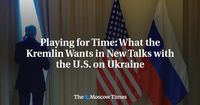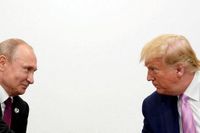As tensions escalate in Ukraine amidst ongoing military assaults, high-level delegations from the United States and Russia are set to converge in Saudi Arabia for a second round of bilateral negotiations aimed at securing a ceasefire. This meeting aims to explore diplomatic avenues as bloody drone strikes continue to ravage regions of Ukraine.
On March 23, 2025, at least seven people were killed, including a five-year-old child, after a barrage of Russian drone attacks targeted Kyiv. According to local authorities, the drones struck residential buildings, igniting multiple fires and engulfing sections of the city in destruction. The timing of these attacks is particularly poignant, occurring just a day before planned U.S.-mediated talks in Jeddah, where Ukraine and Russia are expected to engage in indirect discussions regarding long-term hostilities.
Ukrainian President Volodymyr Zelensky has condemned these relentless assaults, stating, "This week alone, more than 1,580 guided aerial bombs, almost 1,100 strike drones and 15 missiles of various types were used against our people." His remarks reflect the grim reality faced by civilians as drone strikes have become a daily occurrence in Ukraine. Despite agreeing in principle to a limited ceasefire with Russia following a conversation between President Trump and the country’s leaders, the situation on the ground remains dire.
As the Ukrainian capital grapples with the aftermath of the drone bombardment, President Zelensky also met with military commanders on March 22, 2025, discussing the ongoing conflict and the anticipated American presence in the upcoming negotiations. U.S. President Donald Trump expressed optimism about the potential for a ceasefire, suggesting that rational discussions and fostering good relationships between the key leaders involved are crucial. "Rational discussions and having good relationships with presidents Vladimir Putin of Russia and Volodymyr Zelensky of Ukraine are key to negotiating an end to the war," he stated during a recent interview.
The planned talks in Saudi Arabia on March 24 occur amidst a complex backdrop where military advancements and negotiations coexist. Reports indicate that Putin has agreed in principle to Trump’s proposed 30-day ceasefire but emphasized the importance of “nuances” that Moscow will insist on during negotiations. According to a Russian diplomat who spoke to The Moscow Times, "Time is currently on our side, and we’ll try to make the most of it." This perspective underscores the Kremlin's strategy of using delayed negotiations to consolidate territorial gains in Ukraine.
Delegations to the talks will include seasoned negotiators representing Russia, such as Senator Grigory Karasin and Sergei Beseda, both of whom bring extensive experience to the negotiations surrounding the Ukrainian conflict. Their aim will likely be to refine the terms of a ceasefire while maintaining strategic leverage and highlighting Ukraine's positioning as an alleged obstacle to peace. This strategy is part of a broader Russian effort to press for concessions that could provide it with an advantage over Kyiv.
Military activity continued on both sides as the conflict escalated. Ukrainian air defense units reported the successful interception of 97 out of the 147 drones launched by Russia that evening, with additional targets hit in the Rostov and Astrakhan regions as well. Meanwhile, Russia's Ministry of Defense stated that it had successfully shot down 59 Ukrainian drones overnight. These engagements highlight the ongoing intensity of military exchanges, as both nations lean heavily on aerial assaults.
Amidst the diplomatic efforts, the humanitarian situation deteriorates further. Reports from civilians and military personnel in Ukraine narrate harrowing tales of survival during drone strikes—families forced to seek shelter from the air raids, and communities left traumatized by the violence. The psychological and physical toll of the conflict weighs heavily on those enduring these assaults.
The upcoming negotiations in Saudi Arabia present a pivotal moment in the quest for peace, but uncertainties linger regarding both sides' willingness to accommodate each other's demands. Trump’s administration aims for a definitive truce by April 20, recognizing that without a solution, casualties will continue to mount and the anguish of war will persist. In the complex theater of international relations, with each missile fired and each bomb dropped, the hope for peace feels increasingly fragile amidst ongoing hostilities.
Ultimately, as leaders prepare for their meeting, clarity and understanding among the parties are essential. Yet the bombardment continues to risk lives, presenting a haunting reality where acts of diplomacy are overshadowed by the harsh demands of warfare.
As the world watches, the stakes couldn't be higher. With both sides embroiled in military strategies and political ideologies, the quest for peace remains as elusive as ever, shadowed by the consequences of each armed conflict.





